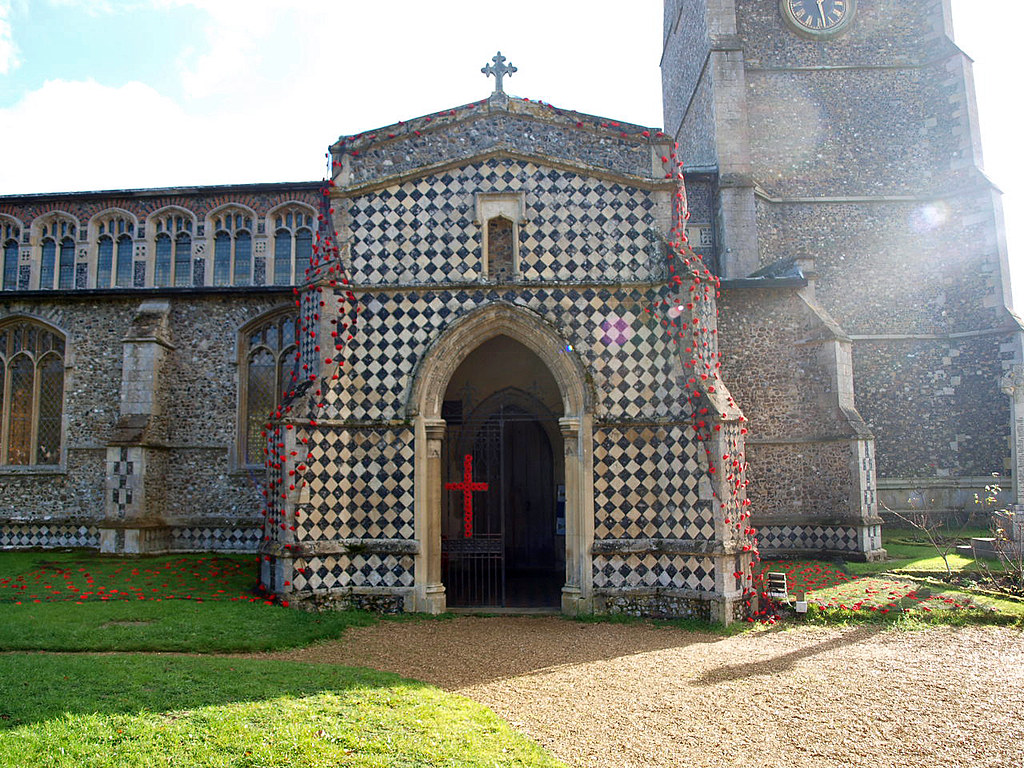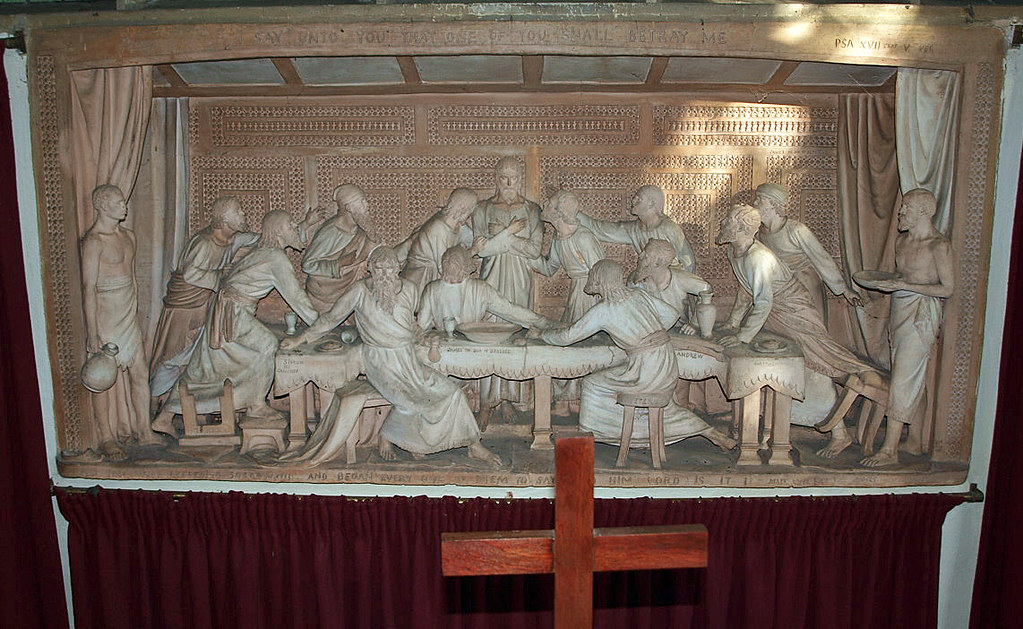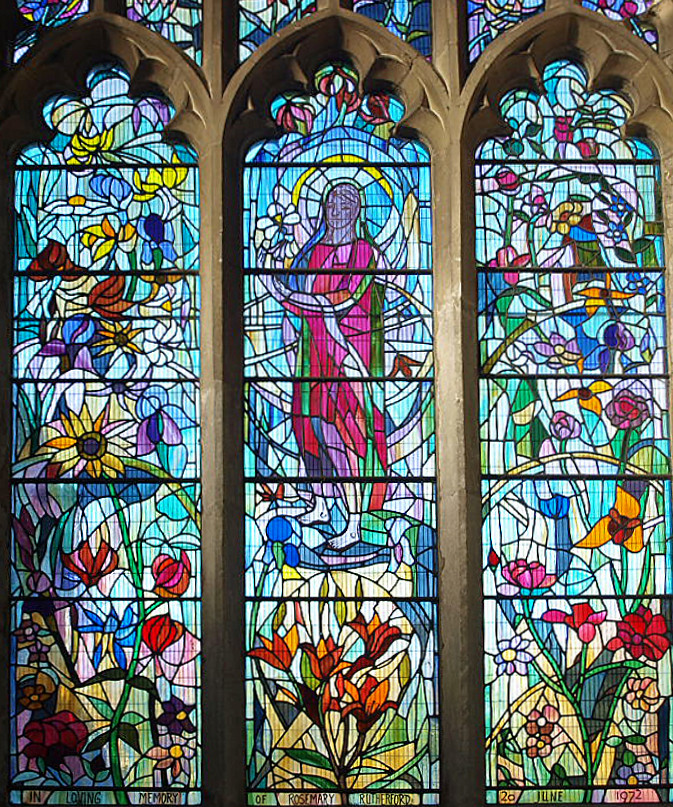ST MARY. Perp throughout. W tower with flushwork panelling on the battlements. N porch with a flushwork lozenge pattern all over. Wood panelling inside the porch gives the date 1541 and has Roman lettering. The N aisle has a base of the same flushwork lozenge pattern. The clerestory has doubled windows and flushwork emblems between them. The S aisle is more modest and has no porch. Seven-bay arcades. Concave-sided octagonal piers, double-hollow-chamfered arches. The piers have on each side at the top a small cusped blank ogee arch. Beautiful roof of low pitch with alternating tie-beams and short hammerbeams, both very delicately ornamented. The shafts for the hammerbeams and braces go down between the clerestory windows. - SCREEN. Dated 1441.* Tall one-light divisions with ogee arches. Original coving and cresting. The dado is painted red and dark green with flowers on. - BENCH ENDS. A few. - REREDOS. Last Supper, by G. Tinworth, in terracotta. Dated 1883. - DOOR. The inner door to the vestry is leather-covered. - PANELLING. In the aisles. One panel is dated 1620. - STAINED GLASS. Bits in the E window. - PLATE. Elizabethan Cup.
* A will of 1448 leaves 6s. 8d. to the fabric of the new rood beam and one of 1459 11 marks to the new stonework (ARA).
WALSHAM-LE-WILLOWS. The picturesque timbered houses of this delightful place stand back from the road in their pleasant gardens, which we found lovely with spring flowers. Full of dignity is the embattled and pinnacled tower of the spacious church, a fine example of 15th century work, and exceptional in the fact that all its chief architecture is of the same period-arcades, roof, clerestory, font, piscina, chest, screen, and painted glass.
A little of the early colour on the fine hammerbeam roof still shows here and there. The bosses are eight-rayed stars, but the angels once supporting it have disappeared. Not a trace of its angelic glory is left; even the angel’s wing which lingered at the rectory has vanished. Charming is the fan-vaulting and cornice of the wide screen. Here, as in the roof, the rich colour has faded, but enough is left to tell us of its primitive beauty. The old glass in the east window is one of the lucky discoveries of the village; it was found in 1805 wrapped in paper in an old box. Its glowing colours are seen to great advantage charmingly mounted on tinted glass, the arms of England and France among the fragments. An ancient ironbound chest with a domed top and one or two panelled benches and poppyheads are left of the original woodwork, and smiling stone cherubs and angel faces look down from the spandrels of the chancel arch.
The most curious thing we found here was a pendant memorial in the nave, a white stone oval about nine inches long. It hangs by a wire from a short rod projecting from the nave wall below the clerestory. On one side an arrow points to a heart and a death’s head, the name Mary Boyce being cut in rude lettering; on the other side is the date of her death in 1685: she is said to have died of a broken heart at 20. There would be hung on this stone, in keeping with the medieval custom here, one of those bridal garlands which were hung by the young girls of the village in remembrance of friends who died too young to marry. We have found such garlands hanging in several churches still, and up to a century ago five garlands were hanging on this stone. The thought of them brings us into Shakespeare, for these garlands were the “virgin crants” allowed at Ophelia’s funeral; and it was the fact that she was permitted these things which angered the priest so that Ophelia’s brother burst out to him with righteous passion:
I tell thee, churlish priest,
A ministering angel shall my sister be
When thou liest howling.
A ministering angel shall my sister be
When thou liest howling.
A fascinating bit of ancient carving is hidden under the book-rest of one of the choir-stalls, a tiny panel hardly seen in the shadow, with fine details only visible by the help of a light. They show the head and body of a man thrust forward and held down under the teeth of a portcullis, and we can well imagine with what glee the old craftsman would work at this droll bit of imagery, and the delight it must have given to generations of choristers weary of long sermons.
At the foot of a pillar in one of the aisles is a group of old tiles, highly glazed with strange designs of heads and animals. The rectory was once the prior’s lodge of a religious house, and has a huge fireplace and thick walls, with a 16th century shield carved on an ancient beam.



No comments:
Post a Comment